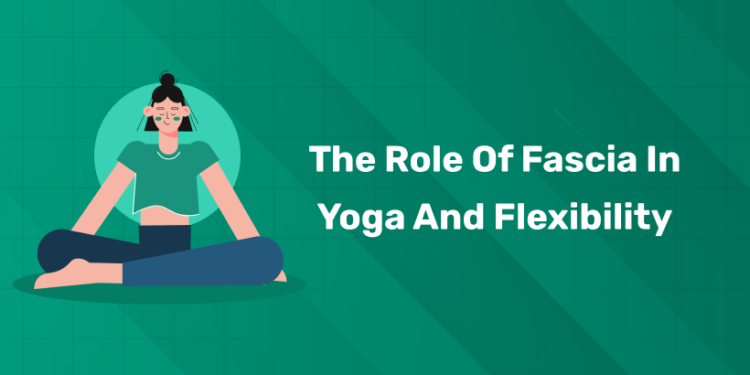Table of Contents
Fascia in yoga is a cloak of stringing connective tissue that surrounds every part of your body. It provides support to your organs, muscles, tendons, nerves, joints, ligaments, tissues, and bones. When your fascia is healthy, it is flexible and stretches with you. When your fascia is tightened, it can reduce movement and cause painful health conditions.
Fascia consists of binder tissue leaves located under the skin. These tissues attach, stabilize, lend strength, maintain the patency of blood vessels, separate muscles and closes different organs. Traditionally, the word fascia has been used primarily by surgeons to describe the description of the tissue observed in the body surrounding other organs, muscles and bones. The definition has been extended to include all collagen soft tissues into the body. The new definition also includes certain tendons, ties, bursae, endomysium, perimysium and epimysium.
Want to become a Yoga Instructor? Join Entri’s Yoga TTC to realise your dreams!
Understanding Fascia: The Body’s Connective Tissues
The fascia is a strip of thin, fibrous connective tissue that ovates and supports every structure in your body. Scientists originally thought that the fascia provided support only to your organs, muscles and bones. Recently, this definition has expanded to include tissue that surrounds all cells, nerves, joints, tissues, tendons and bonds also throughout the body. As part of this discovery, they learned that the fascia is part of a network for whole systems that provide the form and function of each part of your body. It is a continuous tissue layer that is flexible and able to withstand tension.
Fascia is a stringed white fabric made mainly of collagen. Collagen is a protein type that provides flexibility and strength. The fascia is loose, soft and made up of many layers. Hyaluronan is a liquid between each layer. Hyaluronan helps your fascia to stretch while moving. Trauma and Inflammation can dry damage and hyaluronan your fascia. When your fascia is tightened, it can reduce the movement of your muscles and tissues, causing pain and other health conditions.
How Fascia Affect Flexibility and Mobility
1: Which of these is the primary goal of yoga practice?
How Does Fascia Affect Flexibility?
Because the fascia surrounds the muscles, the unhealthy tight facade directly affects the ability of muscles to work optimally. About 50% of your flexibility is determined by fascination. Most joint capsules and 30% of the muscles are fascia, so it is clear that fascia can reduce flexibility or normal range of movement.
Flexibility is not only useful for dancers and other artists. Flexibility will help you perform tasks in everyday life, from picking up something you have dropped until after reaching something from the rear seat of the car.
According to some experts in the study of Fascia, this connective tissue form “trains” in different areas of the body. For example, the surface rear train runs the length of the back of the body, from the legs to the neck. Like the old -fashioned lights of Christmas trees, if one part of the fascia along the train is tight, flexibility is reduced throughout the train.
Unhealthy fascia affects the body more ways than flexibility. When movement is limited due to tight fascia and muscles, you can start compensating, changing your movement patterns and creating new imbalances in the body. Over time, these imbalances create new pain and problems.
Targeting Fascia To Improve Flexibility
Muscle fascia may begin to bind together due to inactivity or injury and cause stiffness that limits the normal range of movement. Loosening of tightness by means of myofascial release techniques can increase flexibility by the entire fascial train. Focusing on one area that seems tight is not solved because the root of the problem can lie somewhere else along this fascial line.
Myofascial release techniques can reduce or release tightness in fascia. These techniques are performed by using direct force on the fascia to extend the tissue and break adhesion.
In the flexibility of resistance (RF), myofascial tissues are stretched, while the person stretches and resists the extension.
In the technique of active release (ART) the therapist holds the pressure on the trigger (adhesion), while the patient goes through the active range of movement.
The Fascia-Mobility Connection
Mobility – the ability to move freely and easily – is strongly influenced by the condition of fascia. The fascia can adapt to the tension placed on it, either more elastic and flexible or tighter and more restrictive. Poor movement patterns, prolonged sitting, dehydration and injuries can lead to adhesion or tightness in fascia, limiting the range of movement and causing discomfort.
Healthy fascia allows the muscles to slightly slide against each other and allows full mobility of the joints. Conversely, when fascia becomes stiff or holding, it limits this movement, leading to a reduction in flexibility and a higher probability of tension or injury. Many athletes and fitness enthusiasts experience limited mobility due to fascial tightness and often mistake it for a muscle problem.
Become a Certified Yoga Instructor
Yoga Teacher Training Course by Entri App: Master authentic yoga techniques, earn certification, and build a successful career as a professional yoga instructor.
Join Now!How to Improve Fascia Flexibility Through Yoga
If you want to improve the flexibility of fascia through yoga, focus on fine and mindful movements with prolonged possessions in poses that focus on different areas of the body, such as hip flexors, shoulders and spine, while incorporating deep breathing to stimulate and relax tension in the fascial system; Favorite positions include children’s position, descending dog, forward bends, pigeon pose and bound angle of position and consider the use of props such as blocks or pads to deepen the sections as needed; Prefer a slow, deliberate practice that is often referred to as “Yoga fascia”.
Key points you remember:
- Focus on deep breathing:
Conscious breathing helps to release fascia and allows deeper sections.
- Hold poses for longer:
Unlike traditional yoga, Fascia Yoga emphasizes that it holds poses for longer duration (often 3-5 minutes) to allow the fascia to gradually release tension.
- Gentle movements:
Avoid violent movements and instead focus on slow and conscious transitions between poses.
- Target key areas:
Pay special attention to areas such as hips, shoulders, spine and lower back, because these tend to hold a lot of fascial tension.
Yoga represents beneficial for flexibility of fascia:
- Children’s position (Balasana): releases tension in the sides, shoulders and lower back.
- Dog pointing down (adho mukha Svanasana): stretches the entire rear chain, including fascia along the spine.
- Pigeon Pose (Kapotasana): Deeply stretches the hips and glutes
- Pose Cat-Cow (Marjaryasana/Bitilasana): Mobilizes the spine and helps to release the tension in the fascial network
- Bound Angle Pose (Baddha Konasana): stretches inner thighs, weaknesses and pelvic floor
- SPHINX POSE (Salamba bhujangasana): gently stretches the lower back and hip
- Sitting forward Bend (Paschimottanasana): It stretches hamstrings and fascia of the lower back
- Half of the fish half of Lord of the Fishes Pose (Ardha Matsyendrasana): The hips and spine open up
Want to read more on Yoga TTC? Click here
Techniques To Improve Fascia Flexibility Through Yoga
You may have heard of the term fascia, but few people are clear what it is or how important their ability to move and exercise. Fascia is an anatomical term referring to a strong connective tissue that surrounds the muscle that is arranged throughout the body as a connected website. Imagine this: If you cut an orange in half and explore the interior, you would see a number of fibers similar to strings separating orange on your wedges. If you looked carefully, in each wedge there would be smaller fibers, each containing small pockets of orange juice. Like these fibers in the orange, the fascia in the body is responsible for the envelope and separation of our muscles.
Because the fascia surrounds our muscles, when it is tight, it reduces the amount of space that your muscles must move and download, which in turn reduces your flexibility. Fascia represents less than 50% of your flexibility and therefore tight fascia leads to a reduction in muscle flexibility. Unfortunately, when you lack flexibility, your ability to perform simple tasks in everyday life. This may be harmful to your health because your body is starting to compensate and change your movement patterns to perform tasks without pain or discomfort. This will place disproportionate stress on the structures of your body, which are not designed for these changed positions or cannot handle these loads.
The Fascia connection works and integrates into the whole body. They are similar to fascial trains. One of these attached fascial lines is known as the surface rear line (SBL). SBL runs along the entire line of our “back”, from the bottom of our feet to the top of our neck. If one part of this fascial line is tight, it will cause reduced flexibility throughout the connected line, reducing the overall movement in this direction. By releasing tightness in any particular fascia using myofascial release techniques, you increase flexibility throughout the line. For example, poor flexibility of hamstring can stem from a tight fascia at the bottom of the foot and/or in your gluteal muscle on the same side. Relaxing or stretching only hamstring does not moderate this tightness because the whole fascial line must be released.
We have found that the fascia plays a major role in your flexibility and your ability to move freely and perform exercise. So what can you do to prevent your fascia from being tight and limiting your ability to move efficiently?
Myofascial release techniques are a common method that we use to reduce or relax tightness in fascia. These release techniques can be made by using direct force on the fascia, stretch slowly and prolong the fascia and mobilize adhesive tissues to reduce tightness.
At Inspire Fitness, we use a number of tools to help myofascial relaxation and to alleviate trigger points in the muscle structure. These tools include foam rollers, top balls, tennis balls and various massage balls. By spending five to ten minutes performing specific myofascial release exercises before training, you can reduce muscle tightness and increase your flexibility. This will improve the efficiency and performance of your exercises and then improve the quality of training.
Lifestyle and Nutrition tips for Healthy Fascia
Here are three things you can do to keep a healthy fascial system:
1. Stay Hydrated
Maintaining the “fluid” of the fascial system is close to the list why we need to remain hydrated. When we are dehydrated, the ECM (which should be a mucus similar to a substance) amplified, sticky and viscous. This strong adhesion in the ECM leads to fascial adhesion (layers of fascia stuck together, aka knots). Maintaining proper hydration helps prevent myofascial adhesion.
2. Move Your Body
Drinking enough fluids is only part of the equation. The second part is to ensure that the liquid can get into all tissues. The best way to achieve this is to move your body. When you move through your body through various new positions, such as those that are carried out in yoga or dance class, the liquid begins to move through the myofascial system.
Imagine squeezing the dirty water from the mushroom. Once the pressure is released from the fungus, it can absorb fresh clean liquid. Our bodies work in a similar way. Stretching works just like pressing the sponge. The release of the section is like relaxing the mushroom; Allows new liquid to enter.
One other effective way to maintain a healthy fascia is the work of “mobility”. Working on mobility includes deeper and more focused work on problem areas, often with the help of an instrument, ball or cylinder to exert pressure directly on the fascia to affect a positive change.
3. Eat an Anti-inflammatory Diet
Diet and nutrition are now being loaded with entities, but one thing that almost everyone agrees that the “standard American diet” is pro -inflammatory. There are many bad effects of systemic inflammation caused by high inflammatory diet. When inflammation affects the fascial system, the body creates pathological or excessive amounts of collagen, a substance similar to adhesive that connects the tissues together. Excess collagen brings excessive adhesion and increases the likelihood of fascial adhesions. Like how dehydration can cause adhesion, inflammation of the system caused by pro -inflammatory diet can also cause adhesion.
With regard to these three things, it will significantly reduce the likelihood of developing myofascial adhesions and maintain your facial system healthy.
Become a Certified Yoga Instructor
Yoga Teacher Training Course by Entri App: Master authentic yoga techniques, earn certification, and build a successful career as a professional yoga instructor.
Join Now!Conclusion
Your fascia is a stringing connective tissue case that surrounds every structure in your body. It provides support to your organs, muscles, tendons, ligaments, tissues, nerves, joints and bones. The fascia is one continuous layer, so it is flexible and moves with your body. When your fascia is tightened, it can reduce the movement of your muscles and tissues, causing pain and other health conditions, so it is important to maintain fascia by healthy movement and stretching the body.
Want to read more on Yoga TTC? Click here
Become a Certified Yoga Instructor
Yoga Teacher Training Course by Entri App: Master authentic yoga techniques, earn certification, and build a successful career as a professional yoga instructor.
Join Now!Frequently Asked Questions
What is the connective tissue and fascia?
Fascia is a thin casing of connective tissue that surrounds and holds every organ, blood vessel, bone, nerve fiber and muscle in place. The tissue does more than provide internal structure; fascia has nerves that make it almost as sensitive as skin.


























